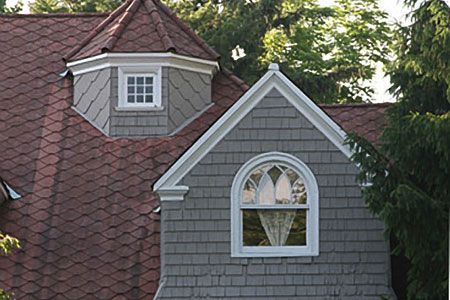The Victorian era is known for its jewel tones, patterned textiles, and ornate designs, and Victorian-era windows are no exception. These windows were functional, decorative, and unique with stained glass and dramatic arches. They also reflected the latest technological advancements with clever sash designs and double-glazed panes, keeping homes warmer and more energy-efficient.
In this guide, we’ll highlight different Victorian-era window types and share details about their style to inspire you and get your creative design juices flowing.
An Eclectic Collection
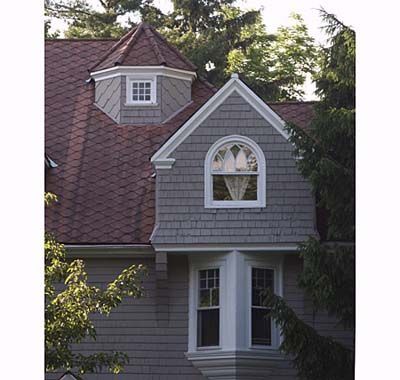
The Victorian era lasted from 1837 to 1901. It was a time of great architectural diversity, combining several historical styles. As a result, homes had an eclectic mix of window designs within a single home.
The fish-scale-shingled house pictured above is an example of this trend. It has a lot of different window types that work together to create an eye-catching home exterior. You can see a six-light square window that highlights the turret. There’s also an arched window with Gothic-inspired muntins, which hails from medieval architectural influences. It also includes a pair of narrow sash windows that forms a bay, which allows more light into the house with a panoramic view.
Basic Geometry
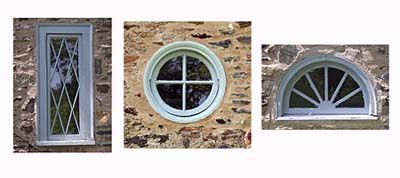
Victorian architects and builders had fun experimenting with window shapes and sizes. This picture shows a house with three distinct window types. The designer created some geometric diversity, which included:
- A half-round window at the crown
- A narrow lattice window that filters light into the space
- A pivoting “porthole” window that gives off nautical vibes and offers ventilation, too
These different window shapes weren’t just practical—they also made for an interesting play of light and shadow inside. Homeowners could show off their personal style while also staying on trend and inviting some light into their dark Victorian homes
A Cameo Appearance
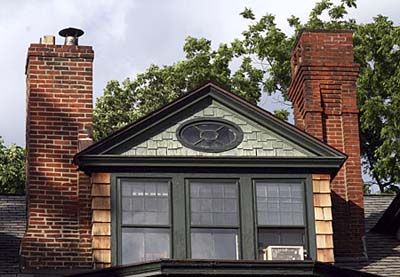
When a contractor installs elliptical windows horizontally like the one in this gable above, they are called cameo windows. Cameos were often punched into the walls along the entry halls of Queen Anne homes for a hint of sophistication. They weren’t just ornamental either; homeowners liked to use them to provide light in an otherwise dark space.
Cameo windows show that Victorian-era builders liked to adapt classical designs to contemporary architectural styles. These windows often featured decorative muntins or stained glass as miniature works of art within a home.
A Raised Eyebrow
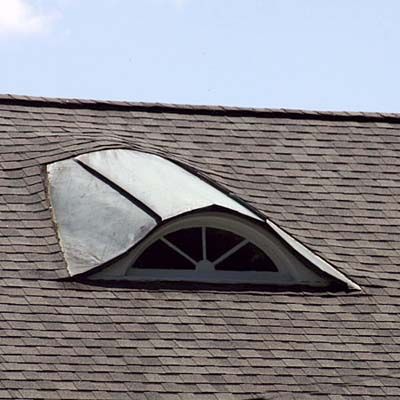
You’ll find the eyebrow dormer, as seen in this image, in many Victorian-era homes. These windows added a lot of character and charm to a home’s pitched roof. A standing-seam copper roof protects the window with an overhang. Eyebrow dormers serve several purposes:
- They allow natural light to penetrate attic areas.
- They create visual interest on the roof plane, breaking up large expanses of shingles.
- They provide additional headroom in upper-story spaces.
The gentle curve of the eyebrow dormer softens the roofline, providing an overall romantic and picturesque quality typical of Victorian architecture. This feature became particularly popular in Queen Anne and Shingle-style homes because it complemented the asymmetrical and complex roof designs. Eyebrow dormers are an architectural feature many contractors use in restorations and new constructions inspired by this period. For more detail, read our guide on everything to know about eyebrow windows.
Big Panes, Little Panes
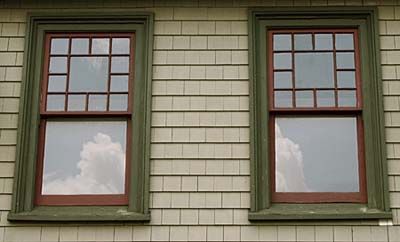
The window configuration shown here has a multi-pane top sash paired with a single-pane lower sash. This design feature was popular in homes built between 1880 and 1915. It’s an example of the technological advancements of the time when larger glass panes became more readily available and affordable. Combining small and large panes offered several benefits:
- Easier cleaning and maintenance of the lower sash
- Improved natural lighting due to the larger, unobstructed lower pane
- Retention of the traditional, multi-pane aesthetic in the upper sash
This glazing pattern was common in Queen Anne and Shingle-style houses because it matched the overall eclectic design. Homeowners and builders liked the flexibility of this design, which varied the number of panes in the upper sash. Many contractors use them in historic home renovations today because they’re practical and provide a classic design.
No Peeking
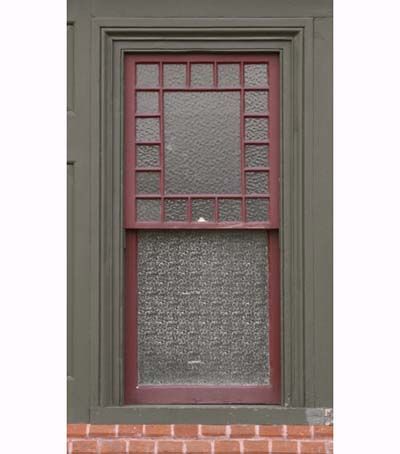
Victorians enjoyed their privacy, especially those who lived in urban areas where houses were close together. To avoid the stares and glares of nosy neighbors, homeowners used patterned glass similar to the one pictured above. These windows were more often used in commercial interiors, such as office doors, but they found their way into residential homes where natural light was at a premium. A few examples where they used patterned glass in homes include:
- Transom lights above bathroom doors
- Windows facing alleys or service areas
- Windows in basement-level rooms
Victorians loved their ornamentation, so the intricate designs of patterned glass accommodated their need for privacy while still providing decorative elements. Today, patterned glass continues to be a popular choice for those looking to balance privacy and embellishment.
Artful Accents
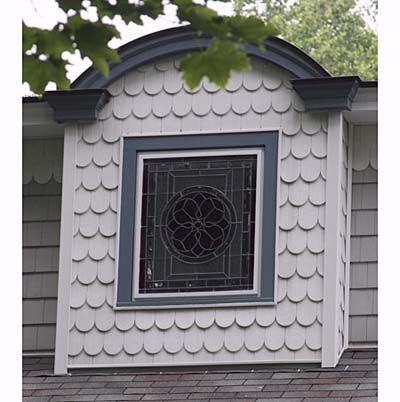
Leaded-glass windows were the crown jewels of Victorian window design. These windows were fitted with clear, patterned, or colored glass. Architects used them sparingly throughout homes, similar to the way a person uses fine jewelry. Creating these detailed windows involved much effort, with craftsmen carefully assembling intricate designs using lead cames to hold the glass pieces in place.
Leaded-glass windows served several purposes in Victorian homes:
- They filtered and colored incoming light, which created an ethereal effect.
- They provided a stunning visual focal point in rooms.
- They showcased the homeowner’s taste and wealth.
These windows were great works of art and featured nature-inspired motifs, geometric patterns, and even figurative scenes. You can still find the legacy of leaded-glass windows in many historic homes. Contemporary designers also draw inspiration from these elaborate designs for modern interpretations.
Side-by-Side
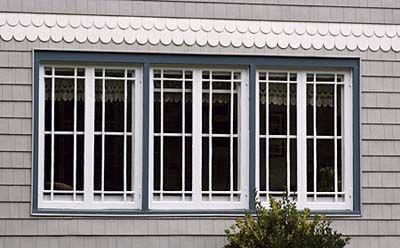
Ribbons or strips of identical windows divided by mullions were a popular feature in Victorian-era homes. This design choice provided several advantages:
- It created a unique architectural accent on the home’s exterior.
- It maintained a balanced appearance, which was different from the single-pane, storefront-like picture windows builders used to replace them with in the mid-20th century.
- It provided ample natural light to interior spaces.
These windows were often found in larger rooms where homeowners wanted a panoramic view. The repetition of identical windows created a rhythm in design and reflected an overall harmony of the home’s exterior. This was also a budget-friendly option for Victorians because they could use smaller, more manageable panes of glass since large glass sheets were expensive and hard to produce.
Casement and Points
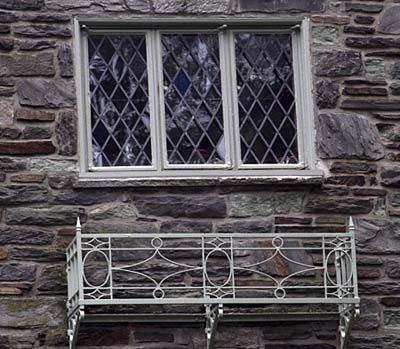
The photo above is an example of Victorian-style casement windows, which swing open along their entire length. The diamond-shaped panes, which are called quarrels, link the Victorian era with medieval architecture. During the Victorian era, there was a renewed interest in medieval design elements, which made casement windows a popular choice.
Diamond-shaped panes in casement windows offered several benefits:
- The intricate pattern created by the quarrels added visual interest to both the interior and exterior of the home.
- The leaded cames holding the panes together provided additional structural support.
- They allowed for the use of smaller pieces of glass, which were more affordable and easier to replace if broken.
These windows were particularly popular in Tudor and Gothic Revival homes because they complemented other medieval-inspired architectural elements. Because of their historical charm and distinctive appearance, you can even find them in new construction today.
The Elizabethan Look
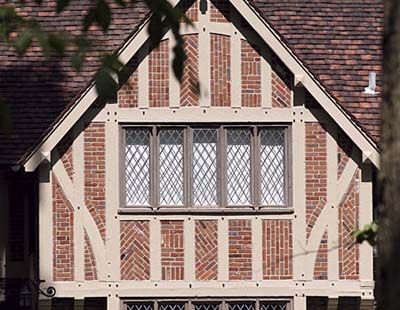
The Tudor Revival style was a popular design in the Victorian era and drew heavily from medieval English architecture. The windows in the image above are an example of the historical detail that characterized this architectural movement. The wood-framed casement windows with quarrels and leaded cames provide ventilation but also serve as a focal point in the home’s design.
Some features of these Elizabethan-inspired windows include:
- Diamond-shaped panes that recall a time when large sheets of glass were unavailable
- Leaded cames that not only hold the glass in place but also create an intricate pattern
- Wood frames that complement the home’s half-timbering and decorative brickwork
Carpenter Gothic
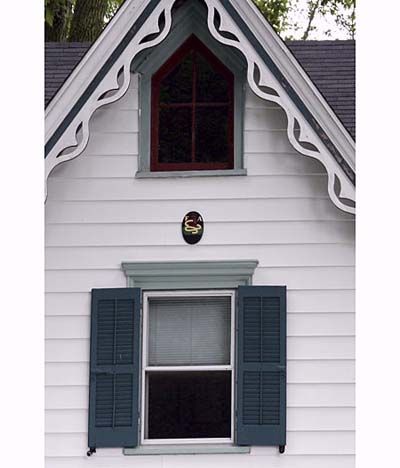
In rural America, you’ll often find a Carpenter Gothic style, which is a unique expression of Gothic Revival architecture. Builders adapted the stone-based Gothic designs of Europe to use the abundant wood resources they found in the New World. The pointed-arch gable window shown in the image above is an example of how carpenters translated Gothic elements into wooden structures.
Characteristics of Carpenter Gothic windows include:
- Decorative bargeboards that frame the window and add visual interest
- Pointed arches that echo the steep pitch of the roofline
- Wood construction that allowed for intricate detailing at a lower cost than stone
These windows were functional but also contributed to the overall romantic and picturesque quality of Carpenter Gothic homes. The style’s popularity in mid-19th century rural America demonstrates the widespread influence of the Gothic Revival movement and its ability to adapt to local materials and building traditions.
Flying High
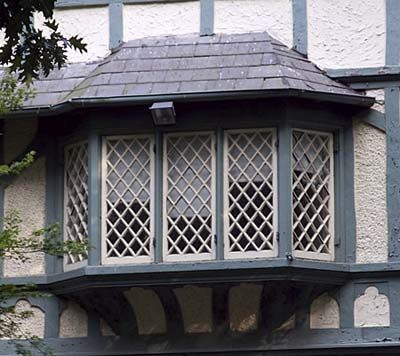
Oriel windows are typically found on upper-story walls. Popular in Gothic Revival and Tudor-style structures during the Victorian era, these windows were supported by brackets or corbels and offered an ornate design to a home’s exterior while also adding more floor space. Oriel windows differ from bay windows because they don’t extend to the ground but appear to “fly” above the lower levels of the building.
Oriel windows offered several advantages to Victorian homeowners:
- They created cozy nooks or window seats within rooms.
- They increased natural light in interior spaces.
- They provided panoramic views from upper floors.
Victorian craftspeople incorporated intricate woodwork, leaded glass, or stone carving into the oriel windows. Whether framed in wood, stone, or masonry, these windows remain one of the most distinctive and cherished elements of Victorian-era architecture.
A Castle Fit for a King or Queen
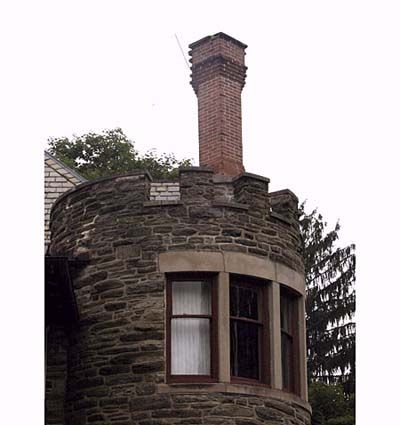
The bowed windows featured in this 19th-century suburban castle are examples of the Victorian era’s affinity for grandeur and architectural innovation. These windows have gentle outward curves that create a softer, more organic look than the angular bay windows of earlier styles. Curved glass was a new technological feature at the time, but specialized glass was both difficult to create and expensive to buy.
Bowed windows offered several benefits to Victorian homeowners:
- They allowed more natural light to enter the room.
- They created additional interior space that homeowners used for window seats or display areas.
- They provided a wider field of view than flat windows.
These elegant windows mimic a castle, which shows the Victorian fascination with historical styles and the desire to create imposing, romantic residences that stood out from their surroundings.
Now That’s Italian!
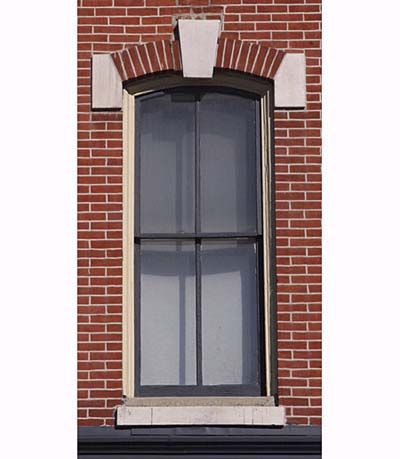
The Italianate style was popular in American architecture from the 1840s to the 1890s, as builders drew their inspiration from the villas of northern Italy. The windows featured in brick Italianate home have several characteristics, which include:
- Decorative keystones above each window, adding a touch of classical elegance
- Generously proportioned two-over-two sash windows, which became standard in most American homes by 1870
- White marble sills that provide a striking contrast to the red brick facade
The large windows allowed ample light into the interior spaces and the ornate detailing reflected the homeowner’s taste and status. It showed the evolution of America’s sophisticated style at the time.
When Centuries Collide
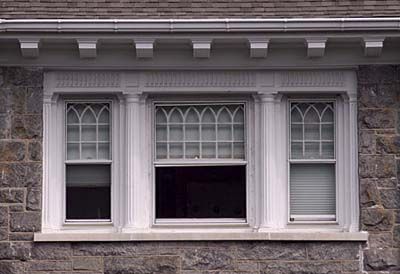
This granite Colonial Revival home is another example of the eclectic nature of late Victorian architecture. It blends elements from different historical periods. The windows play a role in this stylistic fusion through:
- The classically inspired window trim, which represents the earlier Georgian and Federal styles
- The overall massing and use of granite, which looks like Richardson Romanesque architecture
- The pronounced dentil molding, which is a recent addition and adds texture and shadow to the facade
The result of combining different styles pays homage to America’s colonial past while including more recent design trends. It reflects the complex cultural landscape of the late 19th century.
